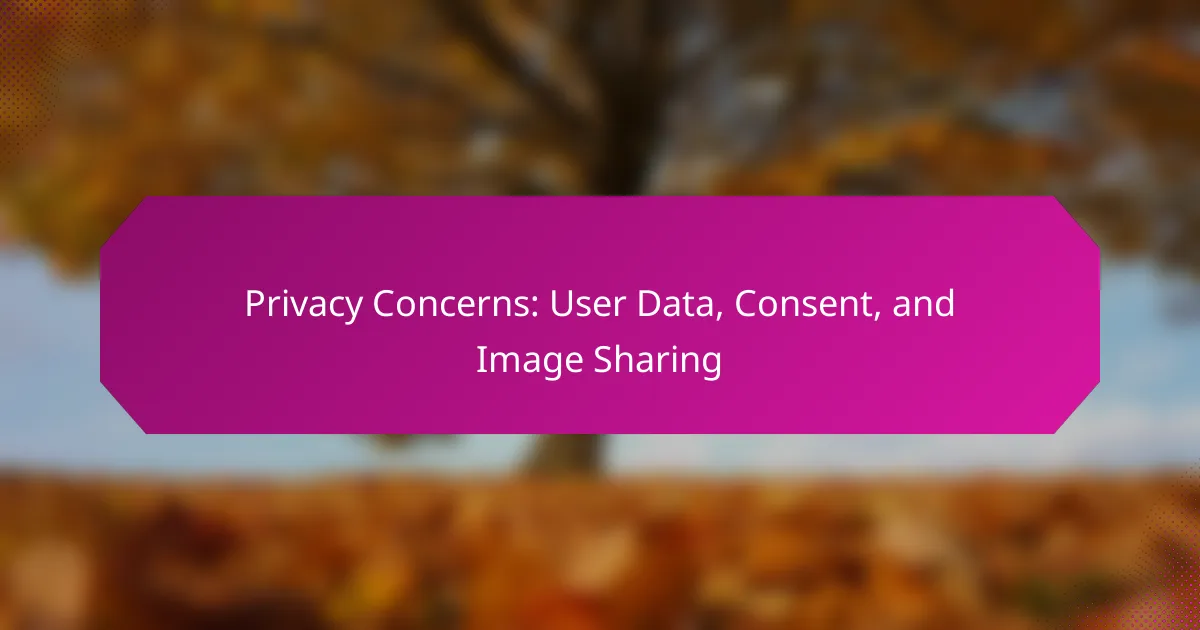In today’s digital landscape, privacy concerns surrounding user data, consent, and image sharing have become increasingly prominent. As individuals navigate various platforms, understanding how to manage consent and protect personal information is essential. Additionally, the risks associated with sharing images online, such as unauthorized use and location tracking, highlight the need for vigilance in safeguarding one’s privacy.
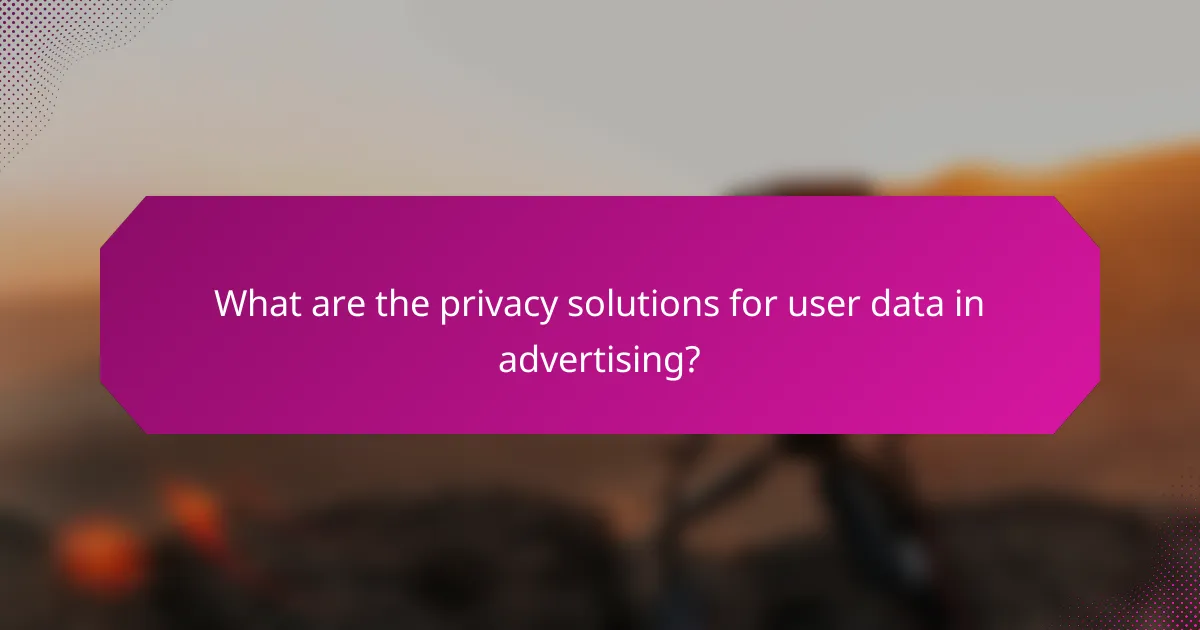
What are the privacy solutions for user data in advertising?
Privacy solutions for user data in advertising focus on protecting personal information while ensuring compliance with regulations. These solutions include various methods and tools designed to enhance data security, manage user consent, and promote privacy-centric advertising practices.
Data encryption methods
Data encryption methods safeguard user data by converting it into a coded format that can only be read by authorized parties. Common techniques include symmetric encryption, where the same key is used for both encryption and decryption, and asymmetric encryption, which uses a pair of keys. Implementing encryption can significantly reduce the risk of data breaches and unauthorized access.
For advertisers, using encryption can help protect sensitive information such as payment details and personal identifiers. It is advisable to choose strong encryption standards, such as AES-256, to ensure robust security.
User consent management platforms
User consent management platforms (CMPs) help businesses obtain, manage, and document user consent for data collection and processing. These platforms streamline the consent process by providing clear options for users to opt-in or opt-out of data sharing. They also ensure compliance with regulations like GDPR and CCPA.
When selecting a CMP, consider features such as customizable consent banners, detailed reporting, and integration capabilities with existing systems. This can enhance user trust and improve transparency in advertising practices.
Privacy-focused ad networks
Privacy-focused ad networks prioritize user data protection by limiting the amount of personal information collected and shared. These networks often use contextual targeting instead of behavioral targeting, which does not rely on tracking user behavior across the web. This approach can lead to more ethical advertising practices.
Examples of privacy-focused ad networks include those that emphasize user anonymity and data minimization. Advertisers should assess the network’s policies on data usage and user privacy to align with their own privacy commitments.
Regulatory compliance tools
Regulatory compliance tools assist businesses in adhering to data protection laws and regulations. These tools can include software that automates compliance checks, tracks data processing activities, and generates necessary documentation. Staying compliant is crucial to avoid penalties and maintain consumer trust.
When implementing compliance tools, ensure they cover relevant regulations in your region, such as GDPR in Europe or CCPA in California. Regular audits and updates to these tools can help maintain compliance as regulations evolve.
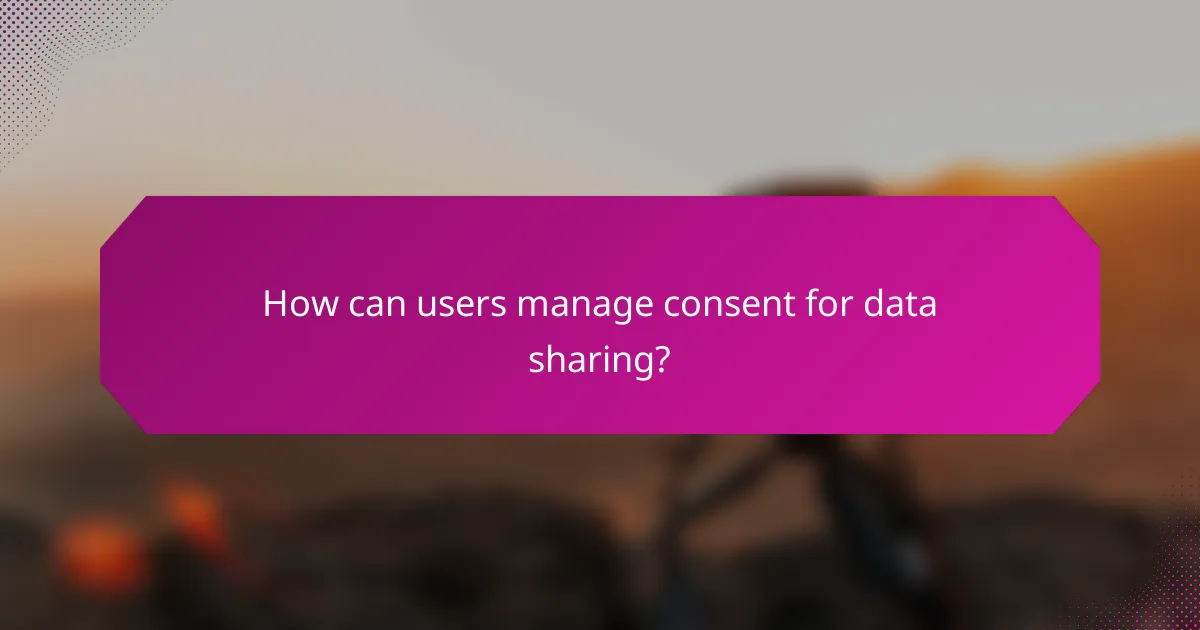
How can users manage consent for data sharing?
Users can manage consent for data sharing by actively engaging with the privacy settings provided by platforms and applications. This involves understanding the mechanisms available for granting or withdrawing consent, as well as utilizing tools that help track and manage personal data usage.
Opt-in and opt-out mechanisms
Opt-in and opt-out mechanisms are essential for users to control their data sharing preferences. Opt-in requires users to give explicit consent before their data is collected, while opt-out allows users to withdraw consent after data collection has begun. Many platforms offer these options, but the clarity of their implementation can vary.
For example, a website may ask for permission to use cookies for tracking purposes, providing an opt-in checkbox. Conversely, an app might automatically collect data unless the user actively opts out through settings. Understanding these mechanisms is crucial for informed consent.
Consent tracking software
Consent tracking software helps users monitor and manage their consent across various platforms. This type of software typically provides a dashboard that displays which services have access to user data and the status of consent for each. Users can easily revoke permissions or adjust settings as needed.
Some popular consent management tools include OneTrust and TrustArc, which comply with regulations like GDPR. These tools can simplify the process, ensuring users remain informed about their data sharing choices.
User-friendly privacy settings
User-friendly privacy settings are vital for empowering individuals to manage their data sharing effectively. Platforms should provide clear, accessible options that allow users to adjust their privacy preferences without confusion. This includes straightforward language and intuitive navigation.
For instance, social media platforms often have dedicated privacy sections where users can easily toggle settings related to data sharing, visibility, and targeted advertising. Regularly reviewing these settings can help users maintain control over their personal information.

What are the risks of image sharing on social media?
Sharing images on social media poses several risks, including unauthorized use, location tracking, and potential data breaches. Users must be aware of these threats to protect their privacy and personal information.
Unauthorized use of images
When images are shared on social media, they can be easily downloaded and reused without the original owner’s consent. This unauthorized use can lead to copyright infringement, where individuals or businesses exploit someone else’s images for profit or personal gain.
To mitigate this risk, users should consider watermarking their images or using privacy settings to limit who can view and share their content. Always be cautious about the platforms you choose for sharing, as some may have less stringent policies regarding image ownership.
Location tracking through images
Many smartphones automatically embed location data, known as geotags, into images taken with their cameras. When these images are shared online, the location information can be accessed by anyone, potentially revealing the user’s home address or frequently visited places.
To protect your privacy, disable geotagging in your camera settings before taking photos. Additionally, review the privacy settings on social media platforms to ensure that location data is not shared publicly.
Data breaches involving shared images
Data breaches can occur when social media platforms are compromised, exposing users’ shared images and personal information. These breaches can lead to identity theft, harassment, or other malicious activities.
To reduce the risk of falling victim to a data breach, use strong, unique passwords for your social media accounts and enable two-factor authentication. Regularly review your privacy settings and be selective about the images you share, especially those containing sensitive information.
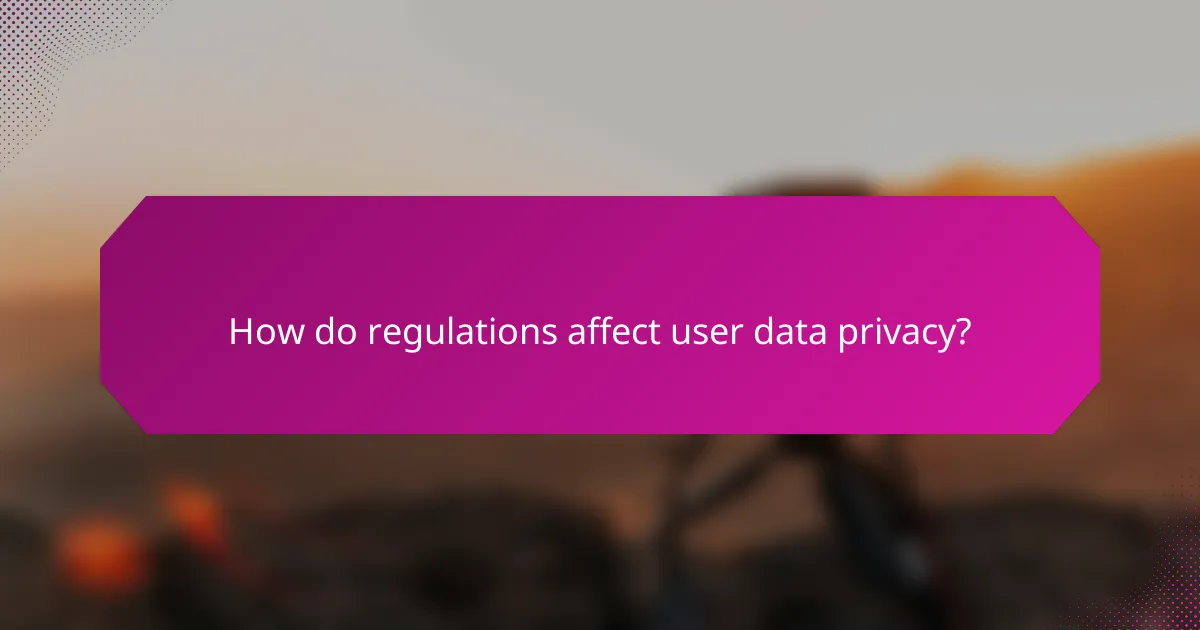
How do regulations affect user data privacy?
Regulations play a crucial role in shaping user data privacy by establishing legal frameworks that govern how businesses collect, store, and use personal information. Compliance with these regulations is essential for protecting user rights and avoiding significant penalties.
GDPR compliance requirements
The General Data Protection Regulation (GDPR) mandates that organizations operating within the European Union (EU) or dealing with EU citizens must adhere to strict data protection standards. Key requirements include obtaining explicit consent from users before processing their data, ensuring transparency about data usage, and allowing users to access and delete their information upon request.
Businesses must also appoint a Data Protection Officer (DPO) if they process large volumes of personal data. Non-compliance can result in fines reaching up to 4% of annual global turnover or €20 million, whichever is higher, emphasizing the importance of adherence.
CCPA implications for businesses
The California Consumer Privacy Act (CCPA) provides California residents with enhanced privacy rights, including the right to know what personal data is being collected and the ability to opt-out of the sale of their information. Businesses must inform consumers about their data collection practices and provide a clear mechanism for opting out.
Companies that fail to comply with CCPA can face penalties of up to $7,500 per violation. As such, businesses operating in California or targeting California residents should implement robust data privacy policies to ensure compliance and build consumer trust.

What are best practices for image sharing?
Best practices for image sharing focus on protecting your privacy and ensuring consent from all parties involved. By implementing strategies like using watermarks, understanding platform privacy policies, and limiting audience visibility, you can safeguard your images and personal data.
Using watermarks on images
Watermarking images is an effective way to protect your intellectual property and deter unauthorized use. A watermark typically includes your name, logo, or copyright symbol, making it clear who owns the image. Consider using a semi-transparent watermark to maintain the visual appeal while ensuring your ownership is visible.
When applying watermarks, place them strategically in areas that are difficult to crop out. This increases the chances that anyone using your image will acknowledge your ownership. Free and paid software options are available for adding watermarks, allowing you to choose a method that fits your needs.
Understanding platform privacy policies
Each social media or image-sharing platform has its own privacy policy that outlines how your images and data are handled. Familiarize yourself with these policies to understand what rights you retain and how your images may be used by others. Look for sections that discuss user consent and data sharing practices.
Pay attention to settings that allow you to control who can view or download your images. Many platforms offer options to restrict access to friends or specific groups, which can help protect your content from wider distribution. Regularly review these settings, as platforms may update their policies or features.
Limiting audience visibility
Limiting audience visibility is crucial for maintaining control over your shared images. Use privacy settings to restrict who can see your posts, ensuring that only trusted individuals have access. This can significantly reduce the risk of unauthorized sharing or misuse of your images.
Consider creating private albums or groups for sharing images with select individuals. This approach allows you to share personal moments without exposing them to a broader audience. Regularly assess your friend lists and group memberships to ensure that your audience remains appropriate.
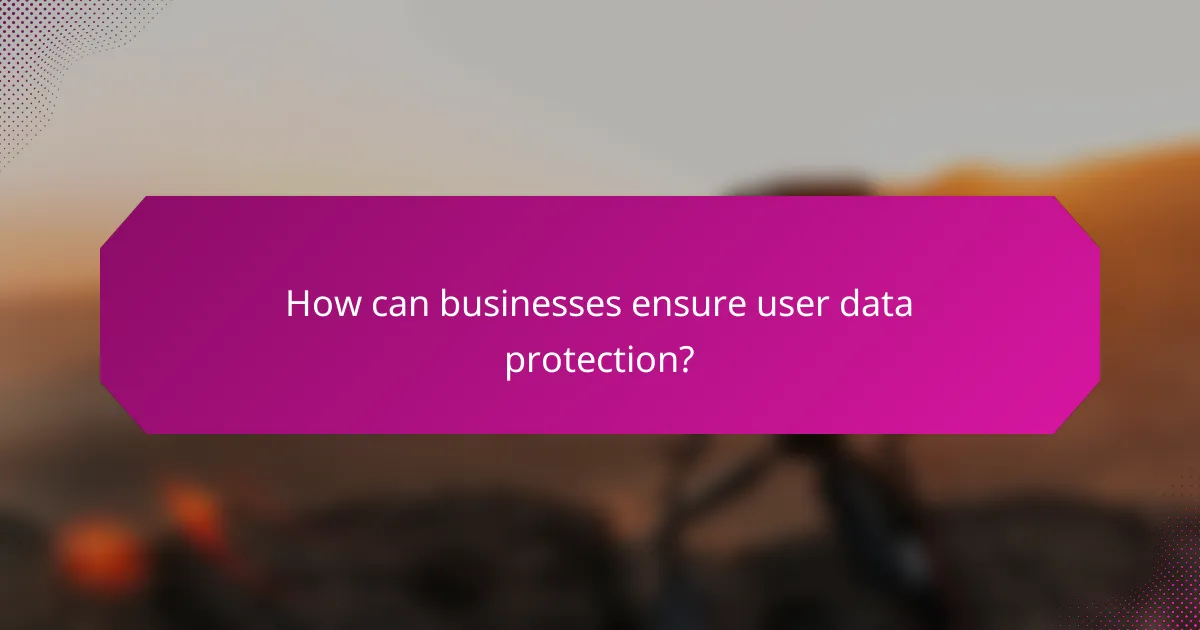
How can businesses ensure user data protection?
Businesses can ensure user data protection by implementing robust security measures, obtaining informed consent, and regularly reviewing their data handling practices. This involves a combination of technical solutions, employee training, and compliance with relevant regulations.
Implementing data anonymization
Data anonymization involves removing personally identifiable information from datasets, making it impossible to trace data back to individual users. This can be achieved through techniques such as aggregation, masking, or pseudonymization. For example, a company might share user data for analysis without revealing names or contact details.
When implementing anonymization, businesses should consider the balance between data utility and privacy. While anonymized data is less risky, it may also be less useful for certain analyses. Regularly reviewing anonymization techniques ensures they remain effective against evolving threats.
Regular security audits
Conducting regular security audits helps businesses identify vulnerabilities in their data protection systems. These audits should assess both technical measures, such as encryption and firewalls, and procedural safeguards, like access controls and incident response plans. Audits can be performed internally or by third-party experts.
To maximize effectiveness, audits should be scheduled at least annually, or more frequently if significant changes occur in the organization or its data handling practices. Following up on audit findings with actionable improvements is crucial for maintaining a strong security posture.
Employee training on data privacy
Training employees on data privacy is essential for fostering a culture of security within an organization. Employees should understand the importance of protecting user data, recognize potential threats, and know how to respond to data breaches. Regular training sessions can reinforce these concepts.
Effective training programs should cover topics such as data handling procedures, recognizing phishing attempts, and the legal implications of data breaches. Incorporating real-life scenarios can enhance engagement and retention of information, ensuring employees are well-prepared to safeguard user data.
